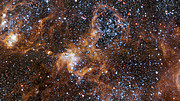The rich region around the Tarantula Nebula in the Large Magellanic Cloud
Tarantula Nebula region in the constellation of Doradus
The rich region around the Tarantula Nebula in the Large Magellanic Cloud (annotated)
Videos
ESOcast 162 Light: A Crowded Neighbourhood (4K UHD)
Zooming in on the Tarantula Nebula
Glowing brightly about 160 000
light-years away, the Tarantula Nebula is the most spectacular feature
of the Large Magellanic Cloud, a satellite galaxy to our Milky Way. The
VLT Survey Telescope at ESO’s Paranal Observatory in Chile has imaged
this region and its rich surroundings in exquisite detail. It reveals a
cosmic landscape of star clusters, glowing gas clouds and the scattered
remains of supernova explosions. This is the sharpest image ever of this
entire field.
Taking advantage of the capacities of the
VLT Survey Telescope (VST) at ESO’s
Paranal Observatory in Chile, astronomers captured this very detailed new image of the
Tarantula Nebula
and its numerous neighbouring nebulae and star clusters. The Tarantula,
which is also known as 30 Doradus, is the brightest and most energetic
star-forming region in the
Local Group of galaxies.
The
Tarantula Nebula, at the top of this image, spans more than 1000 light-years and is located in the constellation of
Dorado (The
Dolphinfish) in the far southern sky. This stunning nebula is part of the
Large Magellanic Cloud,
a dwarf galaxy that measures about 14 000 light-years across. The Large
Magellanic Cloud is one of the closest galaxies to the Milky Way.
At the core of the Tarantula Nebula lies a young, giant star cluster called NGC 2070, a starburst region whose dense core,
R136,
contains some of the most massive and luminous stars known. The bright
glow of the Tarantula Nebula itself was first recorded by French
astronomer
Nicolas-Louis de Lacaille in 1751.
Another star cluster in the Tarantula Nebula is the much older
Hodge 301,
in which at least 40 stars are estimated to have exploded as
supernovae, spreading gas throughout the region. One example of a
supernova remnant is the
superbubble SNR N157B, which encloses the open star cluster NGC 2060. This cluster was first observed by British astronomer
John Herschel in 1836, using an 18.6-inch
reflector telescope
at the Cape of Good Hope in South Africa. On the outskirts of the
Tarantula Nebula, on the lower right-hand side, it is possible to
identify the location of the famous supernova
SN 1987A [1].
Moving to the left-hand side of the Tarantula Nebula, one
can see a bright open star cluster called NGC 2100, which displays a
brilliant concentration of blue stars surrounded by red stars. This
cluster was discovered by Scottish astronomer
James Dunlop in 1826 while working in Australia, using his self-built 9-inch (23-cm) reflecting telescope.
At the centre of the image is the star cluster and emission
nebula NGC 2074, another massive star-forming region discovered by John
Herschel. Taking a closer look one can spot a dark seahorse-shaped dust
structure — the “Seahorse of the Large Magellanic Cloud”. This is a
gigantic pillar structure roughly 20 light-years long — almost five
times the distance between the Sun and the nearest star, Alpha
Centauri. The structure is condemned to disappear over the next million
years; as more stars in the cluster form, their light and winds will
slowly blow away the dust pillars.
Obtaining this image was only possible thanks to the VST’s specially designed 256-megapixel camera called
OmegaCAM.
The image was created from OmegaCAM images through four different
coloured filters, including one designed to isolate the red glow of
ionised hydrogen
[2].
Notes
[1] SN 1987A was the first supernova to be observed with modern telescopes and the brightest since Kepler’s Star
in 1604. SN 1987A was so intense that it blazed with the power of 100
million suns for several months following its discovery on 23 February
1987.
[2] The H-alpha emission
line is a red spectral line created when the electron inside a hydrogen
atom loses energy. This happens in hydrogen around hot young stars when
the gas becomes ionised by the intense ultraviolet radiation and
electrons subsequently recombine with protons to form atoms again. The
ability of OmegaCAM to detect this line allows astronomers to
characterise the physics of giant molecular clouds where new stars and
planets form.
More Information
ESO is the foremost intergovernmental
astronomy organisation in Europe and the world’s most productive
ground-based astronomical observatory by far. It has 15 Member States:
Austria, Belgium, the Czech Republic, Denmark, France, Finland, Germany,
Italy, the Netherlands, Poland, Portugal, Spain, Sweden, Switzerland
and the United Kingdom, along with the host state of Chile and with
Australia as a strategic partner. ESO carries out an ambitious programme
focused on the design, construction and operation of powerful
ground-based observing facilities enabling astronomers to make important
scientific discoveries. ESO also plays a leading role in promoting and
organising cooperation in astronomical research. ESO operates three
unique world-class observing sites in Chile: La Silla, Paranal and
Chajnantor. At Paranal, ESO operates the Very Large Telescope and its
world-leading Very Large Telescope Interferometer as well as two survey
telescopes, VISTA working in the infrared and the visible-light VLT
Survey Telescope. ESO is also a major partner in two facilities on
Chajnantor, APEX and ALMA, the largest astronomical project in
existence. And on Cerro Armazones, close to Paranal, ESO is building the
39-metre Extremely Large Telescope, the ELT, which will become “the
world’s biggest eye on the sky”.
Links
Contacts
Richard Hook
ESO Public Information Officer
Garching bei München, Germany
Tel: +49 89 3200 6655
Cell: +49 151 1537 3591
Email: rhook@eso.org




